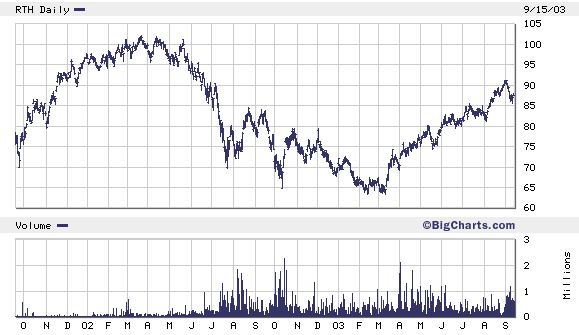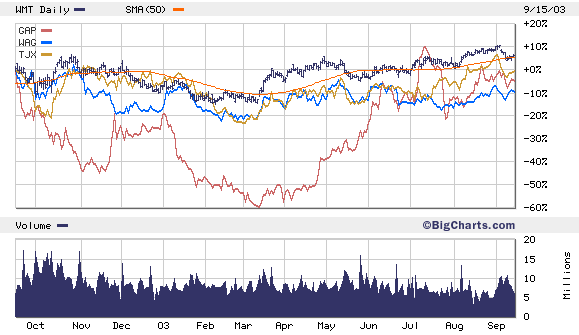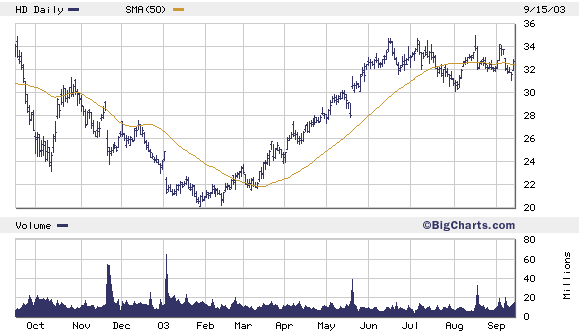The Economy's Most Important Leading Indicator
Rueters reported the following today: "Of the 16,000 U.S. employers surveyed by Manpower in July, 22 percent said they intend to increase their work force in the fourth quarter. That is up from the third quarter, when the forecast predicted only 20 percent of employers would add to payrolls in the survey's weakest job outlook in 12 years. "But the widely watched quarterly survey by staffing company Manpower Inc. MAN.N also found the number of companies expecting to cut payroll is up as well, and fourth-quarter hiring this year will not keep pace with the prior year." Conventional wisdom says the unemployment number is a lagging indicator...that business investment (which leads to increased hiring) comes before the recovery...and by the time the actual hiring happens, the recovery is well under way. But I'd say employment is now THE leading indicator for the economy, simply because its the concern that's closest to home for the average consumer. A consumer worried about losing his job is not going to spend a lot of money, leading to higher business profits, leading to more hiring. Two thirds of the U.S. economy is driven by consumer spending. A few years ago, consumers got confidence from high stock prices. Consumer confidence fueled higher stock prices, which returned the favor and led to higher confidence. In the last few years, housing has been consumer-supportive. With mortgage rates low and home prices rising, consumers felt more secure, more confident. Their chief asset was appreciating in value. They were so confident of perpetually rising house prices, they refinanced the house at 125% of its price, cashed out the difference, and spent it on a new couch. So what if your mortgaged 125% of the value of your home? It would be worth 25% more in a few years, five tops. But one by one...the main crutches of consumer confience have been kicked out. The stock market bubble burst and the wealth effect broke down. And now, mortgage rates are rising. It will be interesting to see tomorrow's housing starts and building permits reports for August. Starts of single family homes reached a 25-year high in in July. Rates are historically low. When rates reach an all time low and starts reach an all time high...where can they go? Rates COULD go lower. But they're not. And starts COULD go higher in a rising-rate environment, although it's not likely. And so housing begins to recede as a source of comfort and confidence for the consumer. Take away the security of your 401(k) and your house and what's left, economically speaking? Your job, of course. As long as you're gainfully employed you can downsize your lifestyle and ride out a bear market in stocks and falling housing prices. But when the average American begins to fear (or realize) that unemployment is reaching a European-like level of permanent high single digits...watch out. As I've said for over a year now, the American labor market is becoming two-tiered. On the top, you have high-paying service industry jobs. And below, you have low paying service jobs. What's being sucked out are the middle income goods-producing jobs...just the jobs that have moved to Mexico and China in recent years. It's unemployment that is going spook the American consumer to the point where he stops buying stocks at 30 times earnings and sells the ones he owns. And it's unemployment that will make it awfully hard for a lot of new homeowners to make their mortgage payments. The job market holds the key. And the job market is getting structurally worse, not better. Incidentally, it's also unemployment that causes consumers to spend less. As if on cue, this also from Reuters, "Sales at U.S. chain stores reversed course and slipped, breaking a three-week run, a report showed on Tuesday. Sales fell 0.3 percent in the week ended Sept. 13, the Bank of Tokyo-Mitsubishi and UBS said in a joint report, after rising 0.5 percent in the prior week." Stalking Weak Retailers If you're thinking of going after the retailers because you agree with my assessment of the job market (or you have your own very good reasons) the vehicle I've used is the Amex-listed retail holder (RTH). RTH is a basket of 20 retail stocks. Its two largest holdings are Wal-Mart (WMT) and Home Depot (HD). As you can see from the chart, RTH is sitting smack on a rising trend-line. Short the Retail Sector With a Single Stock
 You might hold out hope that a strong holiday season will deliver booming Q4 numbers for Wal-Mart and be RTH supportive. But there are enough other retail stocks in RTH to counter Wal-Mart strength (WMT tends to outperform the sector, see chart, also note that even though its outperformed other RTH components like The Gap (GAP), TJ Max (TJX), and Walgreen's (WAG), it's not exactly the picture of technical strength, sitting, as it is, on its 50-day moving average.)
Even a Comparatively Stong WMT May Not Save RTH
You might hold out hope that a strong holiday season will deliver booming Q4 numbers for Wal-Mart and be RTH supportive. But there are enough other retail stocks in RTH to counter Wal-Mart strength (WMT tends to outperform the sector, see chart, also note that even though its outperformed other RTH components like The Gap (GAP), TJ Max (TJX), and Walgreen's (WAG), it's not exactly the picture of technical strength, sitting, as it is, on its 50-day moving average.)
Even a Comparatively Stong WMT May Not Save RTH
 And there's Home Depot (HD). You might not think of HD as an interest rate-sensitive stock. But it's strong upward move from March, along with its 50-day moving average, began to go sideways exactly about the same time the yield on the ten-year bond rose at a record pace in a record short amount of time.
HD, Sensitive to Rising Rates AND Falling Consumer Spending
And there's Home Depot (HD). You might not think of HD as an interest rate-sensitive stock. But it's strong upward move from March, along with its 50-day moving average, began to go sideways exactly about the same time the yield on the ten-year bond rose at a record pace in a record short amount of time.
HD, Sensitive to Rising Rates AND Falling Consumer Spending
 Gee...did HD suddenly realize that higher mortgage rates meant fewer refinancings, fewer cash outs, and fewer Sunday trips for caulk guns and grout? And is it now waiting/relying on continued strength in the retail sector to make up for lack of support from housing?
RTH the simplest way to be bearish the entire sector. And if you want to make it even simpler, buy puts. You play the unemployment figures and the retail figures at precisely the place where they converge...the cash register.
Gee...did HD suddenly realize that higher mortgage rates meant fewer refinancings, fewer cash outs, and fewer Sunday trips for caulk guns and grout? And is it now waiting/relying on continued strength in the retail sector to make up for lack of support from housing?
RTH the simplest way to be bearish the entire sector. And if you want to make it even simpler, buy puts. You play the unemployment figures and the retail figures at precisely the place where they converge...the cash register.

0 Comments:
Post a Comment
<< Home